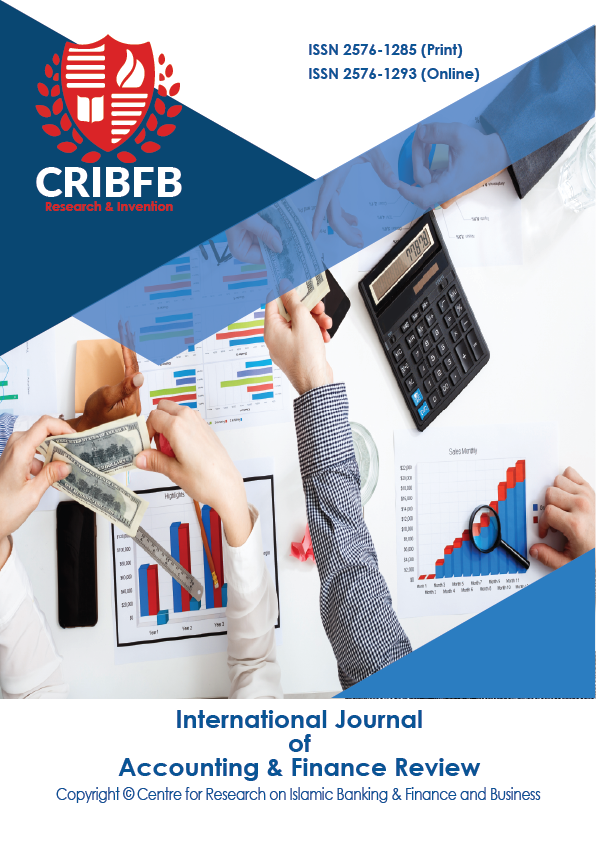Investors' Trading, Market Timing, and Implementation Shortfall: Evidence from the US Financial Market
Main Article Content
Abstract
In this research, we evaluate the US investors' trading pattern and choice of market timing in the presence of implementation shortfall. Results show that when investors decide to trade, implementation shortfall is being ignored. It is observed that stock performance on Wednesday is positive in the presence of positive and significant implementation shortfall i.e., traders do not seem to manage implementation shortfall during trading on Wednesday. It is also observed that investors seem to ignore the implementation shortfall in April. This behavior seems to persist in other types of market times such as turn-of-the-month, week-of-the-month, and quarter-of-the-year effects on implementation shortfall. We conclude that investors behave aggressively to buy stocks during certain days and times of the year ignoring implementation shortfall.
Downloads
Article Details
Section
How to Cite
References
Ariel, R. A. (1987). A monthly effect in stock returns. Journal of financial economics, 18(1), 161-174. https://doi.org/10.1016/0304-405X(87)90066-3
Bhuyan, R., & Khandoker, M. S. H. (2018). Hidden Cost of Trading and Portfolio Performance: A Short Note on Implementation Shortfall. The Journal of Investing, 27(4), 69-80.
Cadsby, C. B., & Ratner, M. (1992). Turn-of-month and pre-holiday effects on stock returns: Some international evidence.
Elango, D., & Al Macki, N. (2008). Monday effect and stock return seasonality: Further empirical evidence. The Business Review, Cambridge, 10(2), 282-288.
Fama, E. F. (1970). Efficient capital markets: A review of theory and empirical work. The journal of Finance, 25(2), 383-417. https://doi.org/10.2307/2325486
French, K. R. (1980). Stock returns and the weekend effect. Journal of financial economics, 8(1), 55-69. https://doi.org/10.1016/0304-405X(80)90021-5
Friday, H. S., & Hoang, N. (2015). Seasonality in the Vietnam stock index. The International Journal of Business and Finance Research, 9(1), 103-112.
Gibbons, M. R., & Hess, P. (1981). Day of the Week Effect and Asset Returns. Journal of Business, 54(4), 579-596.
Hansen, P. R., Lunde, A., & Nason, J. M. (2005). Testing the significance of calendar effects. Federal Reserve Bank of Atlanta Working Paper, (2005-02). https://doi.org/10.2139/ssrn.388601
Iqbal, M. S., Kouser, R., & Azeem, M. (2013). Conventional and Islamic Anomalies in Karachi Stock Exchange. Science International, 25(4), 999–1007.
Jaffe, J., & Westerfield, R. (1985). The week‐end effect in common stock returns: The international evidence. The journal of finance, 40(2), 433-454.
Jebran, K., & Khan, M. A. (2014). The Time of the Month Anomaly in Stock Index Returns: Evidence From Karachi Stock Exchange. Asian Journal of Research in Banking and Finance, 4(7), 160-170. https://doi.org/10.1080/20430795.2017.1289455
Khandoker, M. S. H., Bhuyan, R., & Singh, R. (2016). Implementation Shortfall in Transaction Cost Analysis: A Further Extension. The Journal of Trading, 12(1), 5-21. https://doi.org/10.2139/ssrn.2807317
Kissell, R. L. (2014). The science of algorithmic trading and portfolio management. Elsevier Inc. https://doi.org/10.1016/B978-0-12-401689-7.00003-9
Kohers, T., & Patel, J. B. (1999). A new time-of-the-month anomaly in stock index returns. Applied Economics Letters, 6(2), 115-120. https://doi.org/10.1080/135048599353744
Lakonishok, J., & Smidt, S. (1988). Are seasonal anomalies real? A ninety-year perspective. The review of financial studies, 1(4), 403-425.
Lean, H. H., Smyth, R., & Wong, W. K. (2007). Revisiting calendar anomalies in Asian stock markets using a stochastic dominance approach. Journal of Multinational Financial Management, 17(2), 125-141. https://doi.org/10.1016/j.mulfin.2006.05.003
Perold, A. (1988). The implementation shortfall: Paper versus reality. Journal of Portfolio Management, 14(3), 4-9. https://doi.org/10.3905/jpm.1988.409150
Rozeff, M. S., & Kinney, W. R. (1976). Capital market seasonality: The case of stock returns. Journal of Financial Economics, 3(4), 379-402, https://doi.org/10.1016/0304-405X(76)90028-3
Wagner, W. H., & Edwards, M. (1993). Best execution. Financial Analysts Journal, 49(1), 65-71.
Wong, K. A., Hui, T. H., & Chan, C. Y. (1992). Day-of-the-week effects: evidence from developing stock markets. Applied Financial Economics, 2(1), 49-56. https://doi.org/10.1080/758527546




